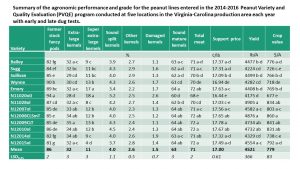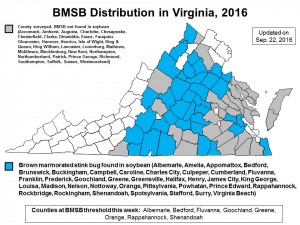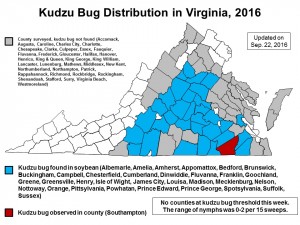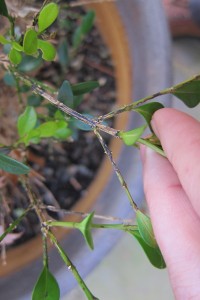Growers in Virginia, North Carolina, and South Carolina are always in need for high yielding, disease resistant and early maturing peanut varieties with good grading and processing quality. The multi-state Peanut Variety and Quality Evaluation (PVQE) program evaluates advanced breeding lines from the North Carolina State University and University of Florida breeding programs that can further be released as Virginia-type cultivars suitable for the region. These lines are compared with the current commercial cultivars, ‘Bailey’, ‘Sugg’, ‘Sullivan’, ‘Wynne’, and ‘Emery’ for yield and quality throughout the production region in Virginia, North Carolina and South Carolina. The 2016 report with the agronomic and grade PVQE data is available here :http: //pubs.ext.vt.edu/AREC/AREC-198/AREC-198.html. A summary of the 2014-2016 agronomic and grade performance is presented in the table below. In average of 3 years and five locations each year, ‘Bailey’ produced 4,477 pounds per acre and the crop value was 776 dollars per acre. Some of the new lines, however, significantly exceeded ‘Bailey’ for both pod yield and crop value; lines N11028ol and N12008CLSmT in particular. Unlike ‘Bailey’, which has normal oil chemistry, all the breeding lines tested recently in the PVQE program are high oleic. This means they have over 75% of their oil content made of oleic fatty acid; and this characteristic extends the freshness and shelf life of the peanuts from 4 to 32 weeks.
Category Archives: Commodity

View the Program: Virginia Eastern Shore Ag Conference and Trade Show
We look forward to seeing you January 25th and 26th at the 27th Annual Eastern Shore Ag conference & Trade Show! You can find the program online at: https://onedrive.live.com/?authkey=%21AEczhxLIHkUCwmY&cid=05F6B732110DB231&id=5F6B732110DB231%2129963&parId=5F6B732110DB231%21813&o=OneUp. Virginia pesticide re-certification and Certified Crop Adviser credits will be available. See the program for more information.
The event will be held at the Eastern Shore Community College Workforce Development Center, 29300 Lankford Highway, Melfa, VA 23410. When you enter the driveway to the Community College, we will be meeting in the building to the left.
The Annual Oyster Roast will be held on Wednesday night, January 25th beginning with a social at 6:00 pm and oysters served at 6:30 pm. Along with oysters, there will be all-you-can-eat barbecue, sides and beverages. Tickets will be $35.00 in advance and $40.00 if purchased the day of the oyster roast.
If you have any questions or concerns please contact either Theresa Pittman (tpittman@vt.edu) or Ursula Deitch (ursula@vt.edu) for accommodation. Thank you!

Virginia Eastern Shore Ag Conference and Trade Show
Join us in Melfa, VA for the 27th Annual Eastern Shore Agricultural Conference and Trade Show on January 25-26, 2017. This event is free, open to the public, and will be held at the Eastern Shore Community College Workforce Development Center. We will offer Virginia Pesticide Recertification credits for categories 1A, 10, 60, and 90. We will also offer Certified Crop Adviser Credits for nutrient management (2), soil and water (1), integrated pest management (4.5), crop management (6), and professional development (0.5). Click on the following link for topic areas being presented: ag-conf-press-release-2017
Dicamba Registered for Cotton and Soybean
Last week Monsanto received EPA registration for XtendiMax with Vapor Grip Technology for use on XtendFlex cotton and Roundup Ready 2 Xtend soybean. Attached is an article authored by Dr. Alan York at NC State pertaining specifically to cotton. I share Dr. York’s sentiments concerning this technology and will echo these same points at winter meetings.

2016 Soybean Yield Contest
The Virginia Soybean Association in cooperation with Virginia Cooperative Extension would like to announce the 2016 Virginia Soybean Yield Contest. The purpose of the Virginia Soybean Yield Contest is to emphasize and demonstrate the practices necessary to produce maximum economic yields, to recognize those producers who grow high-yielding soybeans, and to gather data on the practices utilized by these outstanding producers. With the help of various seed companies, we reward and promote the achievements of Virginia’s most productive soybean farmers.
There are four Soybean Yield Contest categories: 1) Full-Season, Non-irrigated; 2) Double-Crop, Non-irrigated; and 3) Irrigated (Full-Season or Double-Crop; and 4) Most Efficient Yield (MEY). First, second, and third place winners of the full-season, double-crop, and irrigated contest will be recognized with appropriate trophies or plaques. In addition, cash awards of $200, $100, and $50 will be presented to the first, second, and third place winners in each of these categories. The winner of the MEY contest will receive a plaque declaring him or her the most efficient soybean producer in Virginia for that year.
Printable entry forms and contest details can be obtained from your County Agent or on the Soybean Extension and Research website.
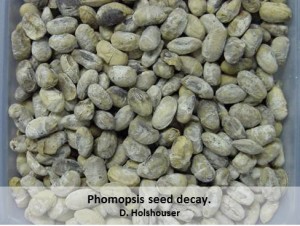
Timely harvest will minimize seed quality problems
The map below shows the amount of rainfall received in Virginia over the last 14 days. And the weather forecast is calling for more. While this rain may still help our double-crop soybean, early-planted early-maturing varieties will run the risk of seed quality problems if they are not harvested soon after maturity. For details of the main diseases that cause these problems, I refer to you to a blog from last fall (Oct 16) when seed quality problems were horrendous – Soybean Seed Quality Continues to Deteriorate.
For details of the main diseases that cause these problems, I refer to you to a blog from last fall (Oct 16) when seed quality problems were horrendous – Soybean Seed Quality Continues to Deteriorate.
But to review, the seed decaying diseases are worse when wet weather is combined with relatively warm conditions, like we are having now. Early-maturing varieties, especially those planted in April and early-May will have the worst seed quality because they are maturing during a warmer time of the year. I’m most concerned about maturity group (MG) III and IV soybeans; MG V’s are not yet mature. Last year, later-maturing varieties fared better than early varieties, as shown in the 2015 variety test data below. We rate seed on a scale of 1 to 5, with 1 being a perfect seed and 5 being an unsaleable product. Usually, anything averaging 2.5 or less is pretty good seed. Double-crop soybean seed quality is always better since they are maturing during a cooler time of the year.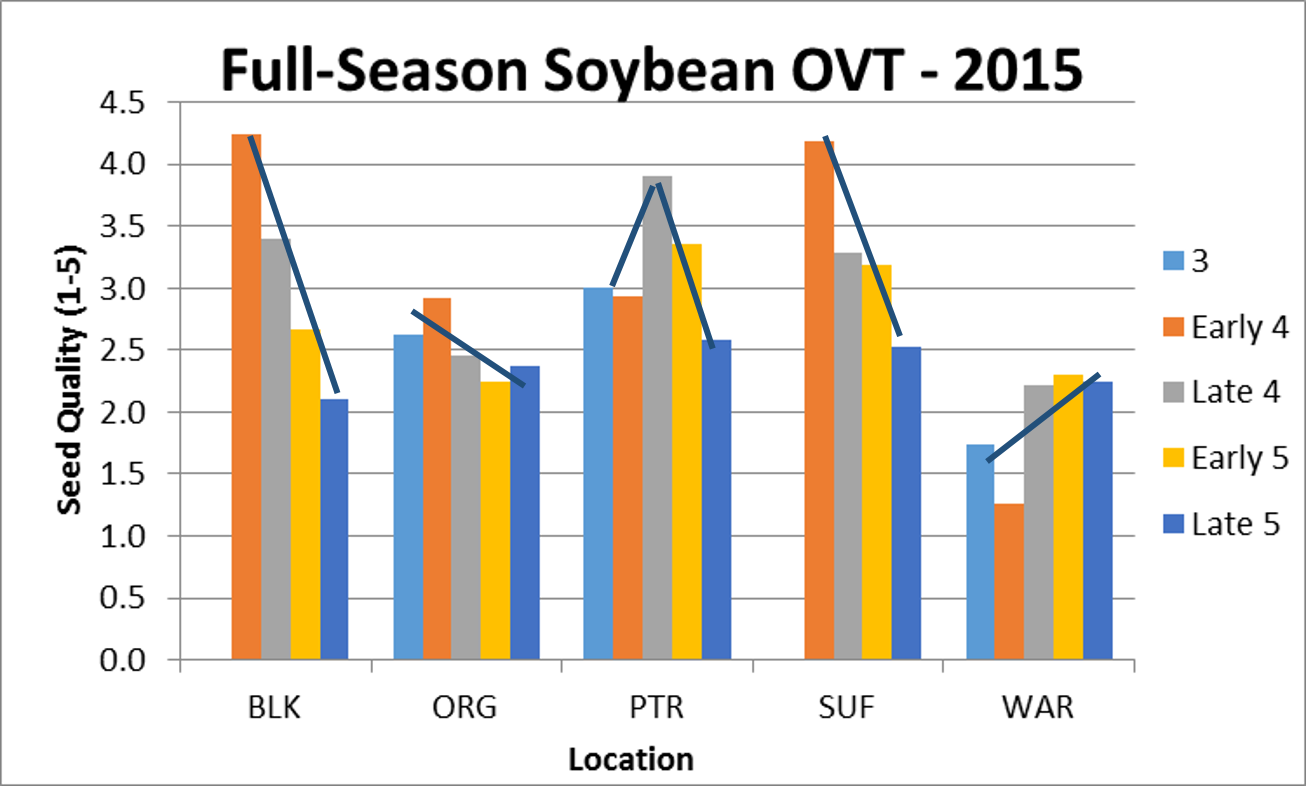
What can you do to minimize these disease? Harvest as soon as possible. Phomopsis seed decay will only get worse the longer that you leave mature plants in the field. And pray for cooler and dryer conditions in October and November.
Registration is open for the Mid-Atlantic Crop Management School.
November 15-17, 2016
Princess Royale Hotel in Ocean City, MD
Registration is open for the 22nd annual Mid-Atlantic Crop Management School. This year’s school will feature 2 ½ days of timely presentations in the areas of crop management, nutrient management, pest management, soil and water management, and climate. This year, the school will also feature the popular Crop School on Wheels field tour (limited to 50 participants). Nutrient management (VA, MD, DE, PA), pesticide, and certified crop adviser (CCA) credits will be available. Register early for the best selection of sessions.
The session schedule is online at: https://cdn.extension.udel.edu/wp-content/uploads/sites/12/2016/09/23151701/2016_CMS_Program_Final.pdf
Registration information is posted at: http://www.cvent.com/events/2016-crop-management-school/event-summary-bbd4a7d2717545af9770626ef761a930.aspx?tw=E3-C1-0B-14-32-A0-CB-AB-1C-D6-9A-06-46-74-20-5F.
Contact Amy Shober (ashober@udel.edu) or Jarrod Miller (jarrod@umd.edu) with questions about the school. We look forward to seeing you there.
The Mid-Atlantic Crop Management School is organized by Extension Specialists from Virginia, West Virginia, Delaware, and Maryland featuring speakers from across the nation.
BMSB and kudzu bug survey of soybean: Sep. 22, 2016 update
Our soybean scouts detected brown marmorated stink bug (BMSB) in three new Virginia counties this week (Halifax, Greensville, and Brunswick). They found soybean fields in the following counties at BMSB threshold (3-5 adults + medium to large nymphs per 2-minute visual count or per 15 sweeps): Albemarle, Bedford, Fluvanna, Goochland, Greene, Orange, Rappahannock, and Shenandoah. Please see the map for more details.
When monitoring, don’t forget about our native stink bug species–we have been seeing moderate to high numbers of green stink bugs in some fields. The threshold for a normal mix of stink bug species (green, brown, and BMSB) is 5 in 15 sweeps.
Peanut maturity progress in Suffolk, VA
The peanut maturity progress from Sep 2nd and until now seems to be optimal. Images taken on Sep 2nd and Sep 12 for ‘Bailey’ (Bailey peanut maturity progress in Suffolk), and ‘Sullivan’ and ‘Wynne’ (Sullivan and Wynne peanut maturity progress in Suffolk) peanut cultivars are presented here. Bailey, regardless when was planted May 2nd or June 4th, seems to be ready to dig in 10 to 15 more days. In the past 10 days, Sullivan shows a substantial increase of black and brown pod content, however the pod color spread is highest for this cultivar. This suggests that Sullivan may have two main crops this year, which is not surprising given the drought stress experienced for most part of August. This situation always makes digging decisions difficult, but we will continue to watch the maturity progress for this cultivar and extend the search to other locations than Suffolk. None the less, location and individual field conditions have significant effects on maturity. Under the conditions of 2016, Wynne is behind Bailey and Sullivan maturity wise. The images of podblasted pods suggest that digging for Wynne is expected in 20 to 25 days from Sep 12. Again, determining maturity in each field individually is the best method for farmers to determine the optimum digging time. Podblasting clinics, such as the one on Sep 19 planned by the new Extension Agent in Southampton County VA, Ms. Livvy Preisser <livvy16@vt.edu>, should be attended rigorously by peanut growing farmers.
Update on Boxwood Blight in Virginia
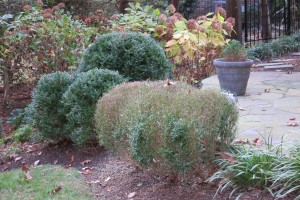
English boxwood defoliated by the boxwood blight pathogen following introduction of infected container plants on the patio. (Photo by A. Bordas)
Recent outbreaks of boxwood blight, caused by the fungus Calonectria pseudonaviculata, are causing concern in Virginia. Boxwood blight can cause severe defoliation of susceptible boxwood, including English and American boxwood, and is of serious consequence to nursery growers, landscapers and homeowners. All diagnoses of boxwood blight in home landscapes made by the Virginia Tech Plant Disease Clinic since last fall are linked to new boxwood purchased from several Virginia locations of one national retailer, and new cases are likely to emerge. (See news article at: http://www.newsadvance.com/news/local/boxwood-blight-hits-lynchburg/article_a2860e97-438c-523a-9c63-202902eaf42b.html).
We strongly recommend that growers purchase boxwood from a nursery or retail outlet that has purchased boxwood exclusively from a boxwood producer in the Boxwood Blight Cleanliness Program (http://www.vdacs.virginia.gov/plant-industry-services-boxwood-blight.shtml). These producers follow stringent practices to avoid the introduction of this disease to their nurseries and are subject to followup inspections by the Virginia Department of Agriculture and Consumer Services.
Symptoms of boxwood blight include leaf spots, black streaking on stems and severe defoliation. Other diseases of boxwood, such as Volutella blight and root diseases, can be confused with boxwood blight; therefore, laboratory confirmation is necessary. Learn to recognize symptoms of boxwood blight by viewing the image gallery on the Virginia Boxwood Blight Task Force web site (http://www.ext.vt.edu/topics/agriculture/commercial-horticulture/boxwood-blight/). Information on best management practices, resistant boxwood cultivars, and sanitizers for cleaning tools is also available on the web site.
In all the cases of boxwood blight diagnosed by the VT Plant Disease Clinic in home landscapes, the disease was introduced on infected boxwood plants. The fungus has sticky spores and is not adapted for movement on air currents; however, spores may stick to and be transported by spray hoses, tools, clothing, shoes, and vehicles. The fungus can also be transported in soil and likely by animals moving through infected plants, e.g. deer, dogs. Infected boxwood may also be present in holiday greenery.
If you suspect boxwood blight, collect symptomatic branch samples with at least a few green leaves still attached. Double bag the samples in sealable bags and take them to your local Virginia Cooperative Extension office (http://www.ext.vt.edu/offices/index.html). Samples will be forwarded to the Virginia Tech Plant Clinic for diagnosis.

